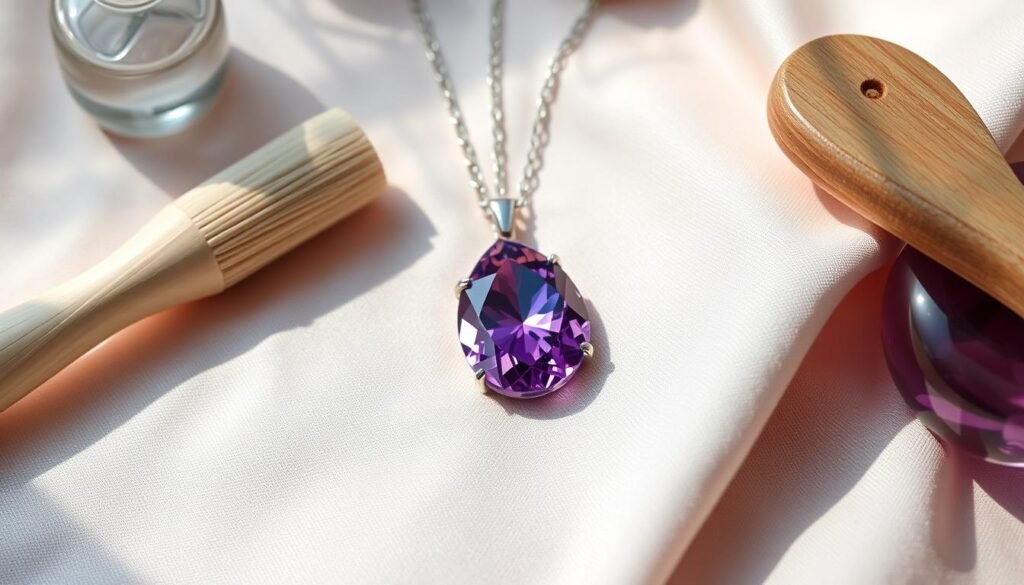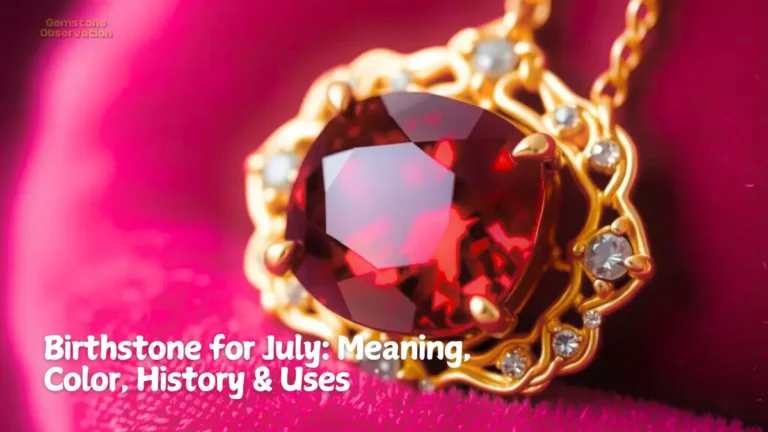Did you know amethyst, the purple gemstone, is February’s birthstone? It’s known for its rich history, symbolic meaning, and versatility in jewelry. Amethyst stands for royalty, personal empowerment, and inner clarity. Its allure and significance go beyond its beautiful color.
Amethyst has fascinated people since ancient times. The name “amethyst” comes from the Greek word “amethystos,” meaning “not drunk.” The Greeks thought it could stop intoxication. Famous figures like Catherine the Great and the Duchess of Windsor loved amethyst for its elegance.
Amethyst’s colors range from pale lilac to deep reddish purple. It’s a gemstone that stands out. It’s also known for its spiritual and metaphysical properties. It symbolizes personal empowerment, inner strength, and clarity of mind. Amethyst is a great choice for any special occasion or to find a gemstone that matches your energy.
Amethyst: The Birthstone for February
As the birthstone for February, amethyst has amazed people for ages. It’s known for its beautiful purple colors and deep history. This quartz variety is calming and soothing, perfect for those born in February.
Amethyst comes from places like Africa, especially Zambia’s Kariba mine, and South America. Its colors vary from lilac to deep purple, with value tied to its color. Despite being common, amethyst is the most prized in the quartz family, making it a top February birthstone.
People born in February and celebrating their 6th wedding anniversary love amethyst jewelry. It’s hard enough for everyday wear, with a rating of 7 on the Mohs scale which is higher than January birthstone. Amethyst is linked to confidence, reducing stress and anxiety, and improving psychic abilities.
Amethyst is often treated to make its color and properties better. It comes in many shapes, sizes, and colors. You can find it in rings, earrings, necklaces, bracelets, and pendants, fitting many jewelry styles.

The Origin and Meaning of the Name “Amethyst”
The name “amethyst” comes from ancient Greek mythology. It means “not drunk” in Greek. This name comes from the belief that amethyst could stop intoxication and keep the wearer alert.
Greek Mythology and Amethyst’s Symbolism
In Greek myths, amethyst was linked to Bacchus, the wine god. The gem’s purple color stood for purity, royalty, and wisdom. A legend says Bacchus turned a maiden named Amethyst into a purple crystal to save her from tigers.
This myth shows how amethyst got its name and its meaning. It’s seen as a symbol of sobriety, wisdom, and spiritual protection. In ancient times, its deep purple was prized, used in royal jewelry, showing its sacred value.

Today, amethyst is loved for its beauty and deep meaning. It’s a favorite for those wanting a gem that represents clarity, peace, and a strong spiritual bond.
Amethyst’s Captivating Colors
Amethyst, the February birthstone, is known for its beautiful purple shades. It ranges from pale lilac to deep reddish-purple. This variety of quartz is captivating due to its natural color range.
The uneven distribution of hues in amethyst creates a mesmerizing effect. While it’s often seen in purple, heat treatment can change its color. It can turn into yellow, green, blue, or even red-orange.
From Pale Lilac to Deep Reddish Purple
Amethyst’s colors are truly captivating, from pale lilac to deep reddish-purple. This makes amethyst a versatile gemstone. It’s perfect for many jewelry designs and personal adornments.

Whether you love the soft, romantic vibes of light lavender amethyst or the deep purple shades, this gemstone has something for everyone. It offers a wide range of colors to match any style or preference.
The Spiritual and Metaphysical Properties of Amethyst
Amethyst, the birthstone for February, is known for its stunning purple colors. It’s also famous for its deep spiritual and metaphysical qualities. This gemstone is linked to ideas like clarity, calmness, and personal power.
The ancient Greeks thought amethyst helped keep the wearer sharp and quick. In the Renaissance, Europeans believed it could calm lovers and soothe the mind. Today, amethyst is used in crystal therapy to help people relax and lower stress.
Amethyst is believed to boost spiritual awareness, intuition, and higher consciousness. It’s also seen as protective and purifying. It’s thought to shield against bad energies and psychic attacks. People born under Pisces and Aquarius zodiac signs, known for their deep feelings, especially value amethyst.
- Amethyst is associated with the 6th and 17th wedding anniversaries.
- Amethyst ranks 7th on the Mohs Scale of Hardness, making it durable for daily wear.
- Major sources of amethyst include Brazil, Uruguay, Russia, South Korea, the United States, and South India.

Looking for clarity, calmness, or spiritual growth? Amethyst’s metaphysical powers make it a great choice for your February birthstone or any special event.
Amethyst in Royal Jewelry and Adornments
Amethyst has been a favorite gemstone among royalty and the wealthy. It’s often found in the finest jewelry and accessories. The Duchess of Windsor’s Cartier-designed amethyst bib necklace is a prime example.
This necklace features 28 step-cut amethysts, a large oval-faceted amethyst, and a heart-shaped amethyst. It’s adorned with turquoise cabochons and brilliant-cut diamonds. These are all set on a detailed gold chain.
The Duchess of Windsor’s Iconic Amethyst Necklace
The Duchess of Windsor loved fine jewelry and wore this necklace often. It’s now known as one of the most famous amethyst in royal jewelry pieces. Its unique design and the Duchess’s elegance have made it a lasting symbol.

For centuries, amethyst has fascinated royalty and the elite. Catherine the Great of Russia was a famous collector of this gemstone. Amethyst has been a sign of wealth, power, and sophistication in high society.
The Birthstone for February with Meaning: Amethyst’s Symbolism
Amethyst is the birthstone for February, carrying deep symbolic meaning. It’s linked to personal empowerment, inner strength, and clear thinking. It also stands for love, happiness, humility, and sincerity. For February-born, wearing amethyst shows their qualities and ties to their birth month.
The gem’s meaning goes back thousands of years. In ancient times, it was highly valued. In Greek myths, amethyst was linked to Dionysus, the god of wine. It was seen as a shield against drunkenness, symbolizing sobriety and clear thinking.
Today, amethyst is still sought after for its spiritual and metaphysical benefits. It’s used in meditation and healing, believed to bring calmness, intuition, and spiritual growth. Whether born in February or just admiring amethyst, it’s a gem worth cherishing.

Where is Amethyst Found?
Amethyst, the birthstone for February, is found in many places around the world. Major sources include Africa, South America, and the United States.
Major Sources and Deposits Around the World
Africa, especially Zambia’s Kariba mine, is a big producer of amethyst. This mine is famous for its deep, rich purple amethyst. Bolivia is also known for its amethyst, with the Anahí mine being a standout.
Brazil is a major player in the amethyst market. It has large deposits of the gemstone. This has made Brazilian amethyst popular among jewelry makers and collectors.
In the United States, Arizona’s Four Peaks mine is famous for its amethyst. It produces some of the finest amethyst, known for its striking color and clarity.
Amethyst is also found in Canada, Mexico, Namibia, and Morocco. Russia used to be the main supplier, but Brazil’s discovery of large deposits has made amethyst more available worldwide.
| Major Amethyst Source Location | Notable Deposits |
|---|---|
| Africa | Kariba mine in Zambia |
| South America | Anahí mine in Bolivia, various locations in Brazil |
| United States | Four Peaks mine in Arizona |
| Other Regions | Canada, Mexico, Namibia, Morocco |
Amethyst is loved and sought after by jewelry enthusiasts and collectors worldwide. Its wide availability and diverse sources make it accessible to many. If you want to start gemstone collection, then start from this guide.

Amethyst: A Treasure from the Anahí Mine in Bolivia
In the Andes mountains of Bolivia, a special mine called Anahí is hidden. It’s famous for its high-quality amethyst and the rare ametrine. The mine’s story began in the 17th century, when a Spanish conquistador got it as a gift.
The mine was forgotten for centuries, but in the 1960s, it was found again. This sparked a new interest in its gemstones. Now, the Anahí mine is known for its amethyst bolivia and ametrine amethyst citrine.
The anahí mine bolivia is famous for its top-quality amethyst. These gems are known for their deep purple colors. The rare ametrine, a mix of amethyst and citrine, is also found here.

Amethyst is the February birthstone, loved by royalty and those seeking spirituality. The Anahí mine’s gems continue to amaze and inspire many.
Caring for and Cleaning Your Amethyst Jewelry
Amethyst is the birthstone for February, known for its deep purple colors. It’s perfect for daily wear but needs proper care to stay beautiful. With a Mohs hardness of 7, it’s softer than diamonds and rubies.
Cleaning Amethyst Jewelry
To clean your amethyst jewelry, mix mild soap with warm water. Use a soft-bristled brush to gently scrub, being careful not to press too hard. Don’t use harsh chemicals or ultrasonic cleaners, as they can harm the amethyst. Also, avoid steam cleaning.
After cleaning, rinse the jewelry well with clean water. Then, dry it with a soft cloth. This gentle cleaning keeps your amethyst pieces shining and colorful.
Heat Treatment and Its Effects on Amethyst
Heat treatment is used to make amethyst colors more vibrant. However, it can make the gemstone slightly more brittle. Too much heat can remove the color or cause it to fade.
When caring for heat-treated amethyst jewelry, avoid high temperatures. Don’t steam clean or expose it to direct sunlight for long. Store it properly, clean it gently, and avoid extreme temperature changes. This keeps your amethyst jewelry looking great.

By following these steps, your amethyst jewelry will stay beautiful for years. A little care and attention will keep this February birthstone captivating and delightful.
Amethyst in Jewelry: Timeless Elegance
Amethyst is a favorite in jewelry for its timeless elegance. It fits many styles and is affordable. You can find it in everything from simple rings to bold necklaces and earrings.
Its purple colors add a touch of royalty to any collection. This makes amethyst a top pick for those wanting elegance in their jewelry.
Amethyst is the birthstone for February birthdays and the 6th and 17th wedding anniversaries. It was once pricey but became more common in the 19th century. Now, you can find everything from budget-friendly pieces to designer gems.
Amethyst is hard enough to be durable in jewelry, from rings to necklaces. It’s versatile, fitting both casual and formal looks. This makes it a classic choice for adding elegance to your style.
Amethyst’s deep colors or soft, pale violet shades are captivating. It’s perfect for rings or stunning necklaces. Amethyst’s beauty and timeless appeal continue to win hearts.
The Versatility of Amethyst in Jewelry Designs
Amethyst’s purple colors and lasting popularity make it a favorite among jewelry lovers. It’s seen in many types of jewelry, from simple stud earrings to eye-catching necklaces.
From Rings to Necklaces and Earrings
Amethyst rings are especially loved, fitting well in both simple and complex designs. Its deep purple looks amazing against gold or silver.
But amethyst isn’t just for rings. It’s also found in bracelets, pendants, and even men’s jewelry. Its versatility suits many styles, from simple to bold.
Amethyst can make any jewelry piece stand out, whether it’s a small earring or a big necklace. Its lasting charm and flexibility make it a classic choice for adding elegance to any look.

Amethyst: The February Birthstone with a Rich History
Amethyst, the stunning purple gemstone, has a long and storied history as the birthstone for February. It has been prized by royalty and the wealthy for centuries. Figures like Catherine the Great and the Duchess of Windsor loved amethyst in their jewelry.
Once, amethyst was as valuable as rubies, emeralds, and sapphires. But, vast deposits in Brazil in the 19th century made it more common. Despite this, amethyst remains a cherished and meaningful birthstone, filled with ancient beliefs and symbolism.
The word “Amethyst” comes from the Greek word “Amethystos,” dating back to around 2000 BC. It has been used since prehistoric times, with the first discovery in France about 25,000 years ago. Amethyst is linked to the crown and third eye chakras, boosting intuition and the immune system.
Major sources of amethyst include Brazil, Uruguay, Russia, South Korea, the United States, South India, and Zambia. Brazil and Uruguay have the largest deposits. Fine quality amethyst stones cost between $20 to $50, making them affordable compared to other gemstones.
Amethyst is linked to Aquarius and Pisces zodiac signs. It symbolizes love, purity, loyalty, protection, royalty, and strength. This February birthstone is a popular gift for Valentine’s Day, engagement, wedding, graduation, and Mother’s Day. It represents inner strength, personal empowerment, and mystical powers.
With its rich history, captivating colors, and spiritual significance, amethyst is a cherished gemstone. It’s the perfect choice to celebrate the February birthstone.
Amethyst: A Gemstone for Royalty and Celebration
Marking Special Occasions with Amethyst Jewelry
Amethyst is linked to royalty and luxury, making it perfect for special moments. It was once for the elite, like Catherine the Great and the Duchess of Windsor, who wore amethyst royal jewelry. Now, it’s a top pick for big events, like the sixth wedding anniversary. An amethyst anniversary gift is a thoughtful way to celebrate a February birthday or a relationship milestone.
The violet colors of amethyst have always been captivating. This quartz variety shows off a range of colors, from light lavender to deep purple. Its royal and spiritual ties make it ideal for amethyst special occasions.
Amethyst is also affordable and accessible, making it great for celebrating loved ones. It’s perfect for engagement rings, anniversary pendants, or February birthday earrings. Amethyst jewelry is elegant and timeless, keeping memories alive for years.
From Brazil’s impressive geodes to custom designs for the elite, amethyst is always inspiring. It stands for royalty, spirituality, and deep personal meaning. This February birthstone is a true treasure, worth celebrating and embracing.

Synthetic vs. Natural Amethyst: What’s the Difference?
Amethyst, the February birthstone, comes in two types: natural and synthetic. Natural amethyst is more common and valuable. Synthetic amethyst has been around since the 1970s. Both types have the same chemical and physical properties, making them hard to tell apart without special testing.
Natural amethyst forms deep in the Earth, exposed to heat and pressure for millions of years. This creates its unique colors and imperfections. Synthetic amethyst, on the other hand, is made in labs. It’s created by heating quartz crystals to mimic natural amethyst.
| Feature | Natural Amethyst | Synthetic Amethyst |
|---|---|---|
| Origin | Formed naturally deep within the Earth’s crust | Created in a laboratory |
| Color | Varies in shades of purple, often with secondary colors like blue or red | Typically a uniform, intense purple color |
| Inclusions | May contain natural imperfections and textures | Highly uniform and inclusion-free |
| Hardness | 7 on the Mohs scale | 7 on the Mohs scale |
| Price | $2 to $30+ per carat, with an average minimum of $20 from reputable sellers | Significantly less expensive than natural amethyst |
Jewelers often don’t test for synthetic amethyst because it’s cheap. But, sellers must tell if an amethyst is natural or lab-created. Buying from trusted sources ensures you get the real gemstone, not a fake.
February Birthstone Alternative
Amethyst is the traditional birthstone for February, but there are other options. Onyx, moonstone, and bloodstone are also linked to the month. Each gem has its own special meaning, giving February-born people more choices to celebrate their birth month.
Onyx is known for its black and white patterns. It’s said to boost strength, courage, and self-control. Moonstone shines with a soft glow, symbolizing new starts, intuition, and feminine power. Bloodstone, with its red spots, is linked to energy, healing, and bravery.
These stones offer a variety of colors and meanings. They let you pick a gem that fits your style and astrological signs. Whether you like amethyst’s calm, onyx’s boldness, or moonstone’s mystique, there’s a February birthstone for you.

Choosing an alternative February birthstone is a great way to celebrate your month. It lets you dive into the rich history and symbolism of these gems. From onyx’s protection to bloodstone’s healing, you have many options to mark your special day.
Conclusion: Embracing the Beauty and Meaning of Amethyst
Amethyst is a gemstone that has captured hearts for centuries. It’s the birthstone for February, known for its amethyst symbolism and beauty. This gemstone has a rich history, tied to royalty and believed to have spiritual powers.
For those born in February, amethyst stands for personal strength and clear thinking. It’s a gem that inspires and empowers. Whether in jewelry or as a natural wonder, amethyst is a timeless treasure.
The amethyst significance goes beyond its looks. It’s known for its calming effect and ability to clear the mind. Adding amethyst to your life, through jewelry or simply enjoying its beauty, brings deep meaning and allure.
Amethyst has been loved by royals and modern-day spiritual seekers alike. It offers a connection to nature and personal empowerment. By embracing amethyst, you can find peace and strength in your life.







